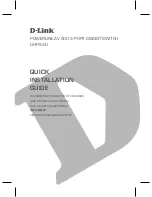
Limiting the Rate of a Port
53
Configuring rate limiting
Rate limiting can be configured on your Switch using the Web interface
or the Command Line Interface (CLI).
Rate limiting can be applied in steps of 1 Mb on 10/100 ports and in
steps of 8 Mb on 10/100/1000 ports.
For a detailed description of the commands that you require to configure
rate limiting refer to the
Management Interface Reference Guide
supplied
in HTML format on the CD-ROM that accompanies your Switch.
Traffic Prioritization
and Rate Limiting
Traffic prioritization and rate limiting can be used together to effectively
manage the traffic on your network:
■
Rate limiting will ensure that the traffic on a connection never exceeds
the rate you specify.
■
Traffic prioritization will ensure that any packets dropped at times of
network congestion are of the lowest priority.
Traffic prioritization and rate limiting are most effective together if the
egress rate rather than the ingress rate is limited on a port; that is the
traffic rate leaving the Switch is limited rather than the traffic arriving at
the Switch. This ensures that the traffic is prioritized before rate limiting is
applied, and that the lowest priority packets are dropped first.
Rate limiting on ingress, as the packets arrive at the port is not as
effective. The Switch cannot determine the order in which packets will
arrive and will not filter by priority.
Summary of Contents for SUPERSTACK 3 3250
Page 8: ......
Page 20: ...20 CHAPTER 1 SWITCH FEATURES OVERVIEW...
Page 43: ...How STP Works 43 Figure 9 STP configurations...
Page 54: ...54 CHAPTER 6 USING TRAFFIC MANAGEMENT...
Page 66: ...66 CHAPTER 8 SETTING UP VIRTUAL LANS...
Page 70: ...70 CHAPTER 9 USING AUTOMATIC IP CONFIGURATION...
Page 98: ...98 CHAPTER 11 IP ROUTING...
Page 102: ...102 APPENDIX A CONFIGURATION RULES...
Page 106: ...106 APPENDIX B NETWORK CONFIGURATION EXAMPLES...
Page 132: ...132 INDEX...
















































